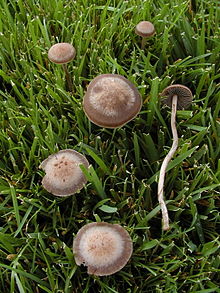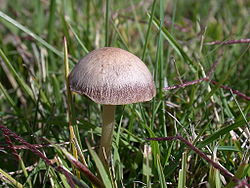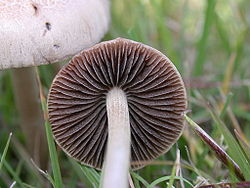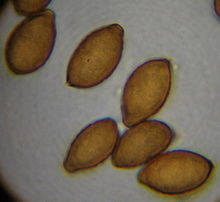- Panaeolina foenisecii
-
Panaeolina foenisecii 
Scientific classification Kingdom: Fungi Phylum: Basidiomycota Class: Hymenomycetes Order: Agaricales Family: Bolbitiaceae Genus: Panaeolina Species: P. foenisecii Binomial name Panaeolina foenisecii
(Persoon) R. Maire.Synonyms Panaeolus foenisecii
Agaricus foeniseciiPanaeolina foenisecii Mycological characteristics 
gills on hymenium 
cap is convex 
hymenium is adnexed 
stipe is bare 
spore print is blackish-brown 
ecology is saprotrophic 
edibility: inedible Panaeolina foenisecii, commonly called the mower's mushroom, haymaker or brown hay mushroom, is a very common and widely distributed little brown mushroom often found on lawns. It fruits in warm weather and contains the hallucinogen psilocybin.[1] In 1963 Tyler and Smith found that this mushroom contains serotonin, 5-htp and 5-hydroxyindoleacetic acid.[citation needed]
It is sometimes mistaken for the hallucinogenic Panaeolus subbalteatus or Panaeolus castaneifolius which both share the same habitat and can be differentiated by their jet black spores.
Contents
Description
- Cap: 1.5 to 3 cm across, conic to convex, chestnut brown to tan, hygrophanous, often with a dark band around the margin which fades as the mushroom dries.
- Gills: Broad, adnate, brown with lighter edges, becoming mottled as the spores mature.
- Spores: Walnut brown, 13 x 7 micrometers, finely roughened with an apical germ pore.
- Stipe: 4 to 6 cm by 2 to 3 mm, fragile, hollow, white to light brown, pruinose and slightly striate.
- Taste: A slightly unpleasant nutty fungal taste.
- Odor: Nutty, slightly unpleasant.
References
- ^ Anastos N, Lewis SW, Barnett NW, Sims DN. (2006). "The determination of psilocin and psilocybin in hallucinogenic mushrooms by HPLC utilizing a dual reagent acidic potassium permanganate and tris(2,2′-bipyridyl)ruthenium(II) chemiluminescence detection system". Journal of Forensic Sciences 51 (1): 45–51. doi:10.1111/j.1556-4029.2005.00033.x. PMID 16423222.
See also
External links
Categories:- Bolbitiaceae
- Fungi of Europe
Wikimedia Foundation. 2010.




